| Living Fossils | |
Fossils are proof that evolution never happened. As the fossil record shows, living things came into being in a single moment, with all the characteristics they possess and never altered in the least for so long as the species survived. Fish have always existed as fish, insects as insects and reptiles as reptiles. There is no scientific validity to the claim that species develop gradually. Almighty Allah created all living things.</p> | |
 |  |
Herring | |
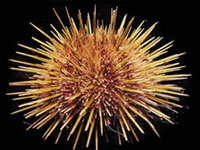 | 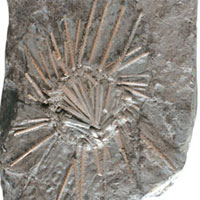 |
Sea Urchin | |
 |  |
Sequoia Leaf | |
 |  |
Veevil | |
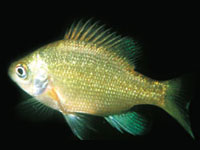 | 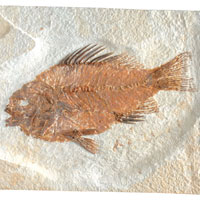 |
Sun Fish | |
 |  |
Juvenile Rabbit | |
According to the theory of evolution, every living species has emerged from a predecessor. One species which existed previously turned into something else over time and all species have come into being in this way. According to the theory, this transformation proceeds gradually over millions of years.
If this were the case, then innumerable intermediate species should have lived during the immense period of time when these transformations were supposedly occurring. For instance, there should have lived in the past some half-fish/half-reptile creatures which had acquired some reptilian traits in addition to the fish traits they already had. Or there should have existed some reptile/bird creatures, which had acquired some avian traits in addition to the reptilian traits they already possessed. Evolutionists refer to these imaginary creatures, which they believe to have lived in the past, as "transitional forms".
If such animals had really existed, there would have been millions, even billions, of them. More importantly, the remains of these creatures should be present in the fossil record. The number of these transitional forms should have been even greater than that of present animal species, and their remains should be found all over the world. In The Origin of Species, Darwin accepted this fact and explained:
If my theory be true, numberless intermediate varieties, linking most closely all of the species of the same group together must assuredly have existed... Consequently evidence of their former existence could be found only amongst fossil remains.25
Even Darwin himself was aware of the absence of such transitional forms. He hoped that they would be found in the future. Despite his optimism, he realised that these missing intermediate forms were the biggest stumbling-block for his theory. That is why he wrote the following in the chapter of the The Origin of Species entitled "Difficulties on Theory":
…Why, if species have descended from other species by insensibly fine gradations, do we not everywhere see innumerable transitional forms? Why is not all nature in confusion instead of the species being, as we see them, well defined?… But, as by this theory innumerable transitional forms must have existed, why do we not find them embedded in countless numbers in the crust of the earth?… Why then is not every geological formation and every stratum full of such intermediate links? Geology assuredly does not reveal any such finely graduated organic chain; and this, perhaps, is the most obvious and gravest objection which can be urged against my theory.26
The only explanation Darwin could come up with to counter this objection was the argument that the fossil record uncovered so far was inadequate. Darwin asserted that when the fossil record had been studied in detail, the missing links would be found.
Believing in Darwin's prophecy, evolutionist paleontologists have been digging up fossils and searching for missing links all over the world since the middle of the 19th century. Despite their best efforts, no transitional forms have yet been uncovered. All the fossils unearthed in excavations have shown that, contrary to the beliefs of evolutionists, life appeared on earth all of a sudden and fully-formed. Trying to prove their theory, evolutionists have instead unwittingly caused it to collapse.
A famous British paleontologist, Derek V. Ager, admits this fact even though he is an evolutionist:
The point emerges that if we examine the fossil record in detail, whether at the level of orders or of species, we find-over and over again-not gradual evolution, but the sudden explosion of one group at the expense of another.27
Another evolutionist paleontologist Mark Czarnecki comments as follows:
A major problem in proving the theory has been the fossil record; the imprints of vanished species preserved in the Earth's geological formations. This record has never revealed traces of Darwin's hypothetical intermediate variants - instead species appear and disappear abruptly, and this anomaly has fueled the creationist argument that each species was created by God.28
These gaps in the fossil record cannot be explained by saying that sufficient fossils have not yet been found, but that they one day will be. Another American scholar, Robert Wesson, states in his 1991 book Beyond Natural Selection, that "the gaps in the fossil record are real and meaningful". He elaborates this claim in this way:
The gaps in the record are real, however. The absence of a record of any important branching is quite phenomenal. Species are usually static, or nearly so, for long periods, species seldom and genera never show evolution into new species or genera but replacement of one by another, and change is more or less abrupt.29
When terrestrial strata and the fossil record are examined, it is to be seen that all living organisms appeared simultaneously. The oldest stratum of the earth in which fossils of living creatures have been found is that of the Cambrian, which has an estimated age of 500-550 million years.
The living creatures found in the strata belonging to the Cambrian period emerged all of a sudden in the fossil record-there are no pre-existing ancestors. The fossils found in Cambrian rocks belonged to snails, trilobites, sponges, earthworms, jellyfish, sea hedgehogs, and other complex invertebrates. This wide mosaic of living organisms made up of such a great number of complex creatures emerged so suddenly that this miraculous event is referred to as the "Cambrian Explosion" in geological literature.
Most of the creatures in this layer have complex systems have complex systems and advanced structures, such as eyes, gills, and circulatory systems, exactly the same as those in present-day specimens. For instance, the double-lensed, combed eye structure of trilobites is a wonder of creation. David Raup, a professor of geology in Harvard, Rochester, and Chicago Universities, says: "the trilobites 450 million years ago used an optimal design which would require a well trained and imaginative optical engineer to develop today".30
The Miracle of Creation That Confounds Evolution | |
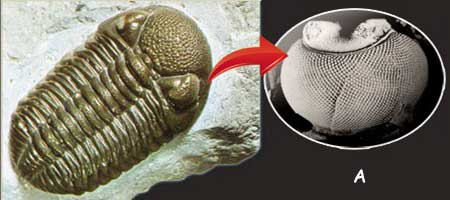 | A. The Eye of Trilobite The trilobites that appeared in the Cambrian period all of a sudden have an extremely complex eye structure. Consisting of millions of honeycomb-shaped tiny particles and a double-lens system, this eye "has an optimal design which would require a well-trained and imaginative optical engineer to develop today" in the words of David Raup, a professor of geology. |
This eye emerged 530 million years ago in a perfect state. No doubt, the sudden appearance of such a wondrous structure cannot be explained by evolution and it proves the actuality of creation. Moreover, the honeycomb eye structure of the trilobite has survived to our own day without a single change. Some insects such as bees and dragon flies have the same eye structure as did the trilobite.* This situation disproves the evolutionary thesis that living things evolved progressively from the primitive to the complex. (*) R.L.Gregory, Eye and Brain: The Physiology of Seeing, Oxford University Press, 1995, p.31 | |
These complex invertebrates emerged suddenly and completely without having any link or any transitional form between them and the unicellular organisms, which were the only life forms on earth prior to them.
Richard Monastersky, a science journalist at Science News, one of the popular publications of evolutionist literature, states the following about the "Cambrian Explosion", which is a deathtrap for evolutionary theory:
A half-billion years ago, the remarkably complex forms of animals we see today suddenly appeared. This moment, right at the start of Earth's Cambrian Period, some 550 million years ago, marks the evolutionary explosion that filled the seas with the earth's first complex creatures. ...the large animal phyla of today were present already in the early Cambrian ...and they were as distinct from each other as they are today.31
Deeper investigation into the Cambrian Explosion shows what a great dilemma it creates for the theory of evolution. Recent findings indicate that almost all phyla, the most basic animal divisions, emerged abruptly in the Cambrian period. An article published in Science magazine in 2001 says: "The beginning of the Cambrian period, some 545 million years ago, saw the sudden appearance in the fossil record of almost all the main types of animals (phyla) that still dominate the biota today".30 The same article notes that for such complex and distinct living groups to be explained according to the theory of evolution, very rich fossil beds showing a gradual developmental process should have been found, but this has not yet proved possible:
This differential evolution and dispersal, too, must have required a previous history of the group for which there is no fossil record.32
How the earth came to overflow with such a great number of animal species all of a sudden, and how these distinct types of species with no common ancestors could have emerged, is a question that remains unanswered by evolutionists. The Oxford University zoologist Richard Dawkins, one of the foremost advocates of evolutionist thought in the world, comments on this reality that undermines the very foundation of all the arguments he has been defending:
For example the Cambrian strata of rocks... are the oldest ones in which we find most of the major invertebrate groups. And we find many of them already in an advanced state of evolution, the very first time they appear. It is as though they were just planted there, without any evolutionary history.33
Interesting Spines | |
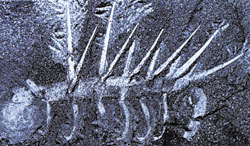 |  |
One of the creatures that suddenly emerged in the Cambrian Age is Hallucigenia (above, left). This and many other Cambrian fossils have hard, sharp spines to protect them from attack. One thing that evolutionists cannot account for is how these creatures should have such an effective defense system when there were no predators around. The lack of predators makes it impossible to explain these spines in terms of natural selection. | |
As Dawkins is forced to acknowledge, the Cambrian Explosion is strong evidence for creation, because creation is the only way to explain the fully-formed emergence of life on earth. Douglas Futuyma, a prominent evolutionist biologist admits this fact: "Organisms either appeared on the earth fully developed or they did not. If they did not, they must have developed from pre-existing species by some process of modification. If they did appear in a fully developed state, they must indeed have been created by some omnipotent intelligence." 34
Darwin himself recognised the possibility of this when he wrote: "If numerous species, belonging to the same genera or families, have really started into life all at once, the fact would be fatal to the theory of descent with slow modification through natural selection."35Period is nothing more or less than Darwin's "fatal stroke". This is why the Swedish evolutionist paleoanthropologist Stefan Bengtson, who confesses the lack of transitional links while describing the Cambrian Age, makes the following comment: "Baffling (and embarrasing) to Darwin, this event still dazzles us".36
Obviously, the fossil record indicates that living things did not evolve from primitive to the advanced forms, but instead emerged all of a sudden and in a perfect state. In short, living beings did not come into existence by evolution, they were created.
Another fact that puts evolutionists into a deep quandary about the Cambrian Explosion is the comparisons between different living taxa. The results of these comparisons reveal that animal taxa considered to be "close relatives" by evolutionists until quite recently, are genetically very different, which puts the "intermediate form" hypothesis, that only exists theoretically, into an even greater quandary. An article published in the Proceedings of the National Academy of Sciences in 2000 reports that DNA analyses have displaced taxa that used to be considered "intermediate forms" in the past:
DNA sequence analysis dictates new interpretation of phylogenic trees. Taxa that were once thought to represent successive grades of complexity at the base of the metazoan tree are being displaced to much higher positions inside the tree. This leaves no evolutionary "intermediates" and forces us to rethink the genesis of bilaterian complexity...37
In the same article, evolutionist writers note that some taxa which were considered "intermediate" between groups such as sponges, cnidarians and ctenophores can no longer be considered as such because of new genetic findings, and that they have "lost hope" of constructing such evolutionary family trees:
The new molecular based phylogeny has several important implications. Foremost among them is the disappearance of "intermediate" taxa between sponges, cnidarians, ctenophores, and the last common ancestor of bilaterians or "Urbilateria." ...A corollary is that we have a major gap in the stem leading to the Urbilataria. We have lost the hope, so common in older evolutionary reasoning, of reconstructing the morphology of the "coelomate ancestor" through a scenario involving successive grades of increasing complexity based on the anatomy of extant "primitive" lineages.38
25. Charles Darwin, The Origin of Species: A Facsimile of the First Edition, Harvard University Press, 1964, s. 179![]()
26. Charles Darwin, The Origin of Species, s. 172, 280![]()
27. Derek A. Ager, "The Nature of the Fossil Record", Proceedings of the British Geological Association, cilt 87, 1976, s. 133![]()
28. Mark Czarnecki, "The Revival of the Creationist Crusade", MacLean's, 19 Ocak 1981, s. 56![]()
29. R. Wesson, Beyond Natural Selection, MIT Press, Cambridge, MA, 1991, p. 45![]()
30. David Raup, "Conflicts Between Darwin and Paleontology", Bulletin, Field Museum of Natural History, Cilt 50, Ocak 1979, s. 24![]()
31. Richard Monestarsky, "Mysteries of the Orient", Discover, Nisan 1993, s. 40![]()
32. Richard Fortey, The Cambrian Explosion Exploded?, Science, Cilt 293, No 5529, 20 Temmuz 2001, syf. 438-439![]()
33. Richard Dawkins, The Blind Watchmaker, London: W. W. Norton 1986, s. 229![]()
34. Douglas J. Futuyma, Science on Trial, New York: Pantheon Books, 1983. s. 197![]()
35. Charles Darwin, The Origin of Species: A Facsimile of the First Edition, Harvard University Press, 1964, s. 302![]()
36. Stefan Bengston, Nature, Vol. 345, 1990, s. 765![]()
37. André Adoutte, Guillaume Balavoine, Nicolas Lartillot, Olivier Lespinet, Benjamin Prud’homme, and Renaud de Rosa, "The New Animal Phylogeny: Reliability And Implications", Proceedings of the National Academy of Sciences, 25 April 2000, vol 97, No 9, pp. 4453-4456![]()
38. André Adoutte, Guillaume Balavoine, Nicolas Lartillot, Olivier Lespinet, Benjamin Prud’homme, and Renaud de Rosa, "The New Animal Phylogeny: Reliability And Implications", Proceedings of the National Academy of Sciences, 25 April 2000, vol 97, No 9, pp. 4453-4456![]()